#SkiMilwaukee: Wilmot, Grand Geneva, Alpine Valley, and Little Switzerland
A Midwest ski adventure begins, with Slopes
Monday, February 3, 2025, LaGuardia Airport, sometime between 5 and 6 a.m: “Where you headed?” the Delta clerk asks as I hoist my ski bag onto the scale.
He expects me to say Salt Lake or Denver or maybe Reno, but I say “Chicago” and like any New Yorker would he just said, “well I don’t get that one very often” and asked no further questions. And this is how my annual Midwest ski run began.
Wilmot Mountain, Wisconsin – 10:07 a.m.
“The Midwest is nice,” they say. Hokey-dokey and hunky-dory. Ned Flanders on repeat across a dozen states. “People in the Midwest are so nice,” they say and maybe you believe it. But don’t believe it because it’s bullshit. There are plenty of assholes from the Midwest, including, when the mood hits, me.
But gosh darn it if the crew at Wilmot Mountain was not, in fact, the nicest group of folks I’ve ever encountered. The fellow minding Lift 6 promised to investigate the fact that the adjacent park tows were not yet running, though I had only asked him what time they opened. The Broseph stationed at Lift 1, acting at first as though I’d just arrived to his birthday party with a boombox and a case of Stroh’s, enthusiastically explained how the Illinois state line ran parallel to this old double chair, just a few feet off into the woods. After I spent nine minutes stalled on Lift 3, the load-station attendants apologized on my next run, remembering, I guess, that I’d been among the stranded.

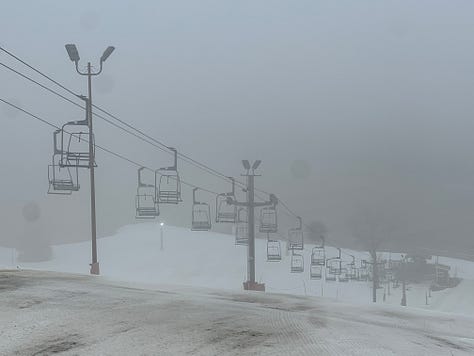


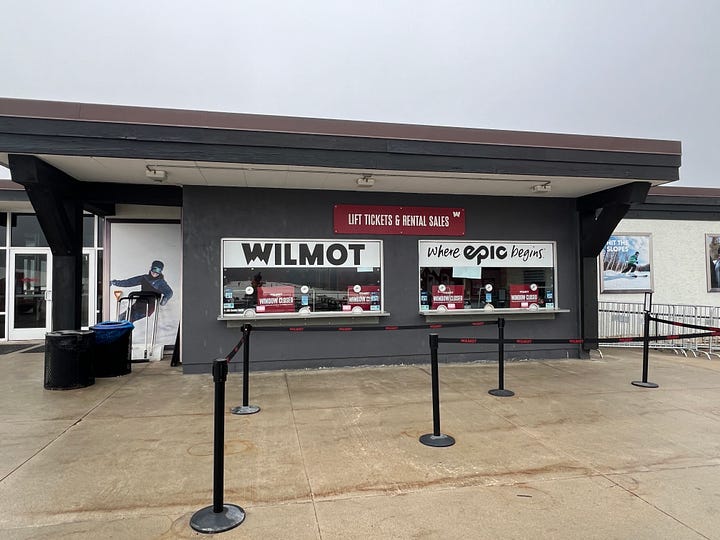

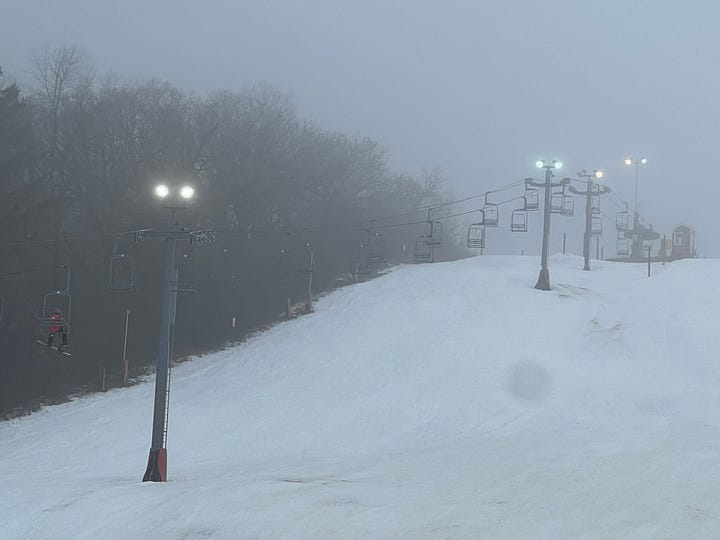
There’s not much else to say about Wilmot because there’s not much to Wilmot. Vail owns it, one of their original Midwest treasures. One thing Vail does a consistently good job with, even at its smaller mountains, is ensuring that all terrain is accessible at all times, even on a Monday morning, when it surely must cost more to activate the joint than it could possibly be bringing in.
I can hear Wilmot skiers saying “huh?” as I attempt to describe their perpetually overrun bump. The place is prototypically Midwest – a disorienting wave of snow rising from a brown wasteland, nearly clearcut, swarmed with people and machinery. This 120-acre ski area runs 12 ski lifts. That’s 12 acres per lift. The number for Whistler is 248 acres per lift (33 lifts – seven of them carpets – to serve 8,171 acres).
But. Weekdays for the win. On this Monday morning, Wilmot’s 194 vertical feet, soft and pleasant, skied fast and easy.
The Mountaintop at Grand Geneva – 12:03 p.m.
This bump is as delightful as it looks, a set of knolls, three short chairlifts, trees spaced in wander-able groves:
This is a ski area that doesn’t really need to be a ski area, because it’s an amenity for a giant resort owned by a company of giant resorts, none of which are ski resorts (except for, sort of, this one). What I like in a small ski area is an occasional illusion of bigness, a moment of man-I-can-see-it drama that transports the mind to the Elsewhere that is the dimension of all great ski moments. For me this claimed-211-footer that Slopes tells me is a 111-footer delivered that moment in this drop beneath chair A, in a kamikaze-angled line that could have been cut from the northern Greens:
Or maybe Geneva delivered that moment with this run down among the dotted trees:

The place is tidy but also funky and rattletrap, a dated facility doing its just-enough to stay alive half an hour down the road from a Vail racehorse. But the place does serve some schools, does net some park kids, is re-ordering itself to exist in the modern world. That Basin terrain park has been, in effect, temporarily abandoned and moved to either side of lift C, while the resort works out timing on a hoped-for installation of snowmaking in the now barren area. Will the ropetow stay? Maybe. I’ll discuss it more when I host the mountain’s director on the pod in June.
Alpine Valley – 2:07 p.m.
How many Alpine Valleys do you suppose exist in America? Would 10 surprise you? A dozen? Unlikely. So perhaps the biggest shock is this: America is home to just three Alpine Valleys. This is the only such triplicate among our 502 active ski areas, though we have two Crystals, two Brightons, two Magics, two Timberlines, two Big Bears, two Powderhorns, two Sundowns, two Powder Ridges, two Hidden Valleys, two Black Mountains, and two Winter Parks. Some of them append “Ski” or “Mt.” to their names, but they fool no one. We once had two Sugarloafs, but one (in Michigan), closed. We had two Shawnees, but thankfully that’s over (name change). It’s weird that Cooper and Copper are practically next-door neighbors, and that Holiday Valley and Holiday Mountain are in the same state (New York). But that is not the same thing as sharing an identical name. There is one extra special thing about our Alpine Valleys: two of them, the ones in Michigan and Wisconsin, are owned by the same company, Wisconsin Resorts, a six-mountain outfit that is the most opaque ski conglomerate in U.S. skiing (Vail owns Alpine Valley, Ohio; apparently, the same person once owned all three Alpine Valleys, a strange story that I would like to learn more about).
I say that Wisconsin Resorts is dark and mysterious and impenetrable because it is the only American ski area operator of any size or reputation that I have been unable to establish contact with. And that’s too bad, because it is an interesting company executing a more effective version of Vail’s urban strategy.
We can look, for example, at this (claimed) 388-vertical-foot snow fortress bolted across the countryside 23 minutes north of Grand Geneva. Alpine Valley, Wisconsin is absurd in the same ways that Wilmot is absurd: 15 lifts across 90 acres, seven of them chairlifts, three of those high-speed quads. At 1,421 and 1,426 feet long, rising 279 and 290 vertical feet, respectively, Super Glide and Valley Flyer are the sixth- and seventh- shortest detachable chairlifts in America.
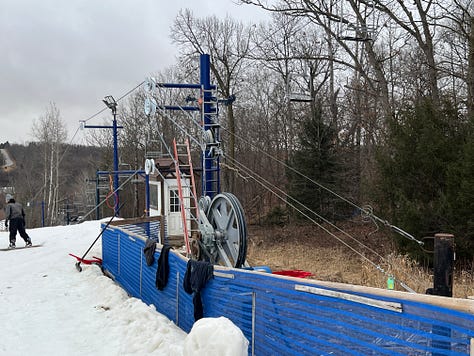
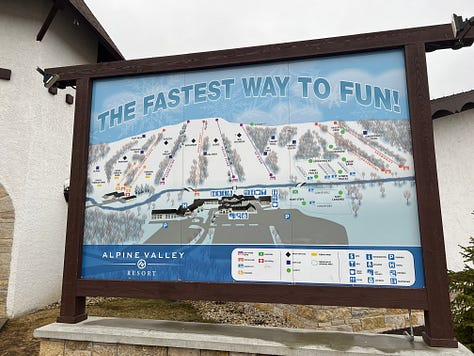



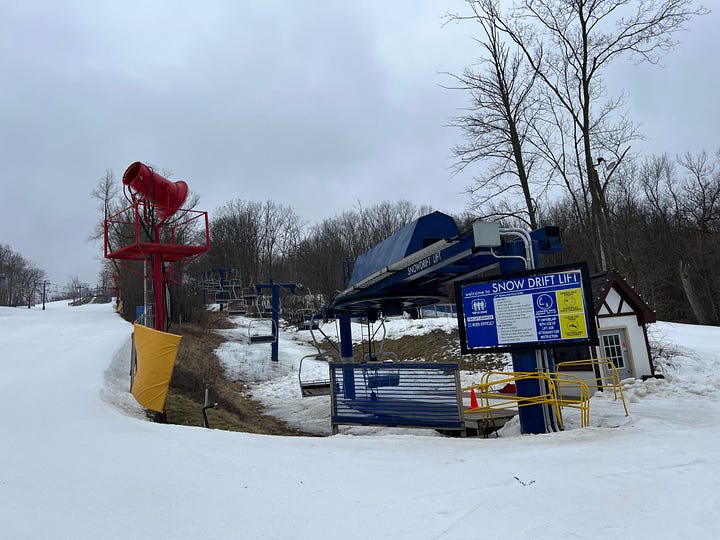
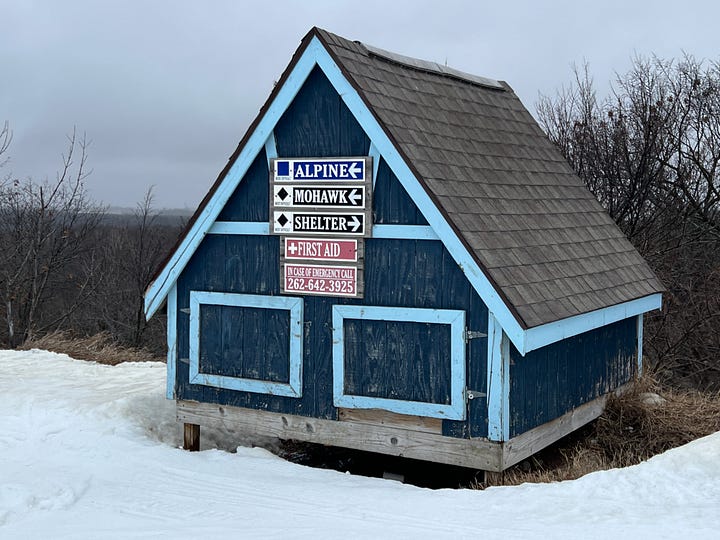
But Alpine Valley, Wisconsin is just the most extreme example of the Wisconsin Resorts Way, which flings high-speed lifts all over the place. Mt. Holly, Michigan runs 15 lifts, two of them high-speed quads, rising 243 and 277 vertical feet. Bittersweet, also in Michigan, spins two detach quads among its 11 lifts. Snow Flyer is 319 feet tall. Sweet Express, depending upon the source, somewhere between 200 and 300. Six of Wisconsin Resorts’ seven detachables rank among the shortest such lifts in America:

Wisconsin Resorts’ high-speed lifts are the only detachables I have ever seen, anywhere in the world, that lack safety bars (the two newest, at Mt. Holly and Bittersweet, are equipped with them). Check out the Super Glide chair (video by Stuart Winchester):
Anyway, the skiing: straight up, straight down, empty on a Monday, but you can imagine it. The swarms. Smart layout – parks over here, steeps there, gentle kid stuff yonder. But all ski areas ought to keep a few tuck-aways, easy-to-miss warpzone gates that transport skiers, however briefly, to some otherplace. I find one of these off the Mohawk trail, a break in the trees, what looks like a landing skier’s left. Angle in and a narrow shot opens through the woods, canopied and still-groomed at three o’clock, a ropetow strung like something grandpa spun together for our amusement. A dozen turns through nothing with no one, fast and tight, snow soft. Not sky snow, probably, but machine snow. Snow that shouldn’t be here but is here because skiing is so cool we will make it happen anywhere there is a bump in the earth and temperatures that make you want to put a coat on. Momentarily lost in this snow tunnel I could be anyplace, Vermont or Colorado or the Catskills or North Dakota. A rhythm, dynamic and explosive and uniquely modern, that entrances some primitive part of us. Movement and adventure, quest and discovery. Poised and stilled in the moment.
Exit. Wisconsin on a Monday. An old Hall triple. And back to the top.

Little Switzerland - 4:15 p.m.
The Schmitz Brothers had rebuilt falling-down Nordic Mountain and Little Switzerland would be next. It was 2011 and the Slinger, Wisconsin bump had been closed for four years. A glacial-ripple-turned-ski-hill, opened in 1941, discarded by modernity, lodge disintegrating in the elements, lift terminals flooded, boxed in by the ever-growing suburbia poised to devour it. But no. This ski hill would be a ski hill again.
Today the complex glitters like something newbuilt. That nailed-shut lodge looms wood-stained and glittering in rich-guy lakehouse style. The parking lot is paved and everything is neat and ordered like the product of an organizing influencer’s Instagram reel. Almost nothing is new but everything appears to be. Even the pair of up-and-over Riblet doubles, built in 1964 and 1971, feel recently notched into the hillside.
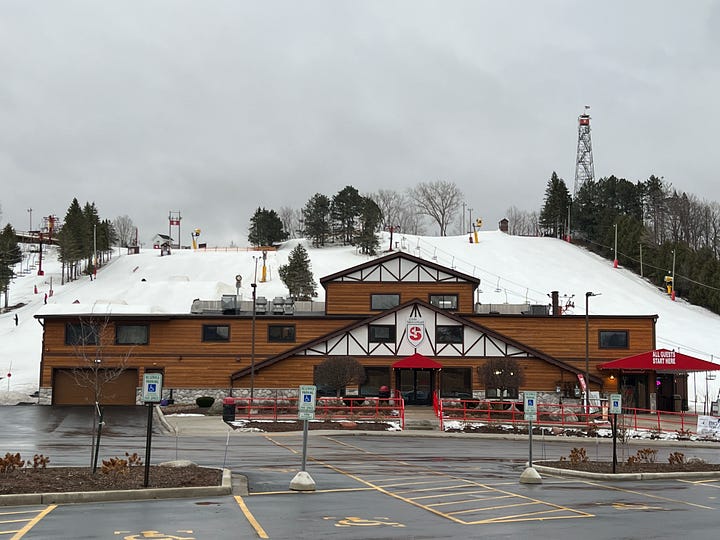

Rick Schmitz meets me at the ticket window, ready to ski. He’d toured me around Nordic two winters ago and would guide me around Switz today. At 50 acres, a guide would seem extraneous, but the Schmitz Brothers have packed incredible variety into this constrained footprint since re-opening the ski area for the 2012-13 ski season. Looker’s right as skiers ride Lift 1 is a clear-cut, tow-served race hill, steep and wide; left of that a gentler pitch; farther left, features tight and many, rearing in odd angles beneath Chair 3.
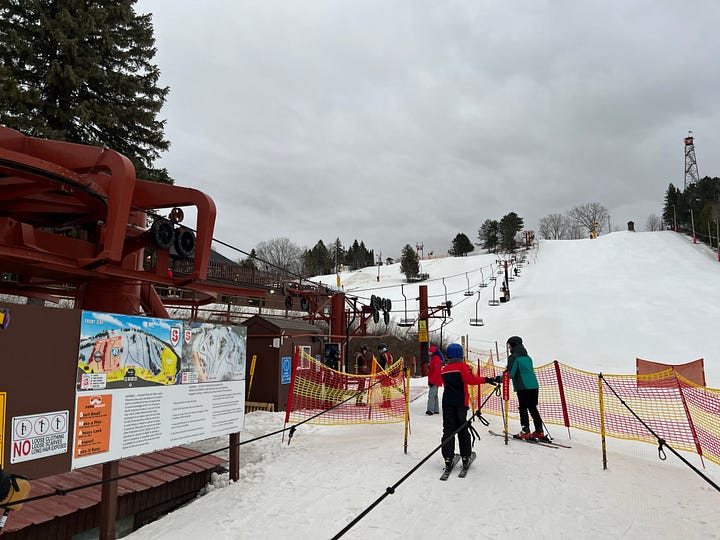
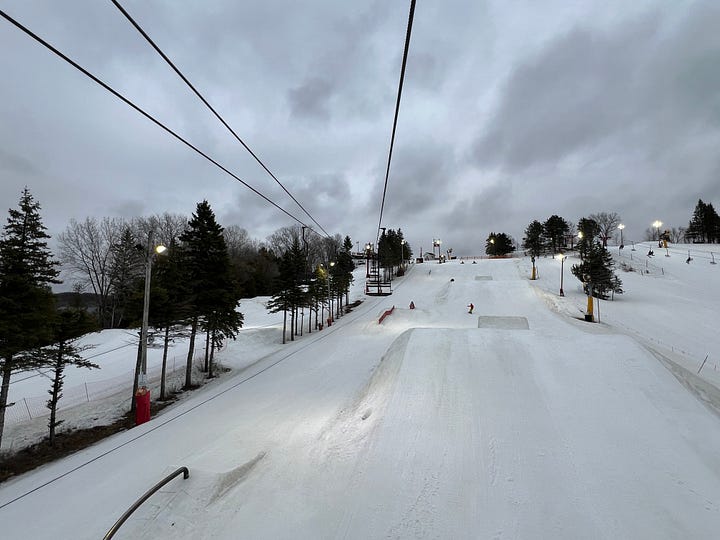
Off the backside, where Chairs 1 and 3 crest and transform into Chairs 2 and 4, a frontside mirror in height and breadth, but with narrower trails, blazed and arcing through the trees, a small terrain park far skier’s right with its own whipsaw ropetow of late installation, a factory, Schmitz tells me, for Park Brahs who would soon lap the varsity features plunging beneath 3.
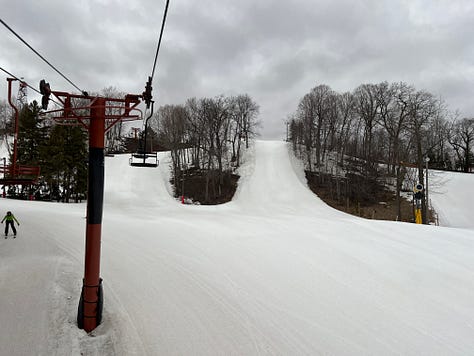
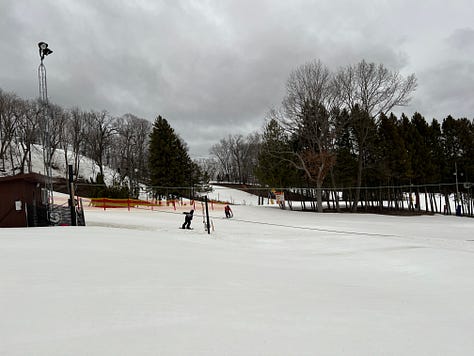



And then, improbably, hanging off a green-circle traverse looker’s right off the frontside, what feels like an entirely different ski area, broad and gentle, an acres-wide meadow served by conveyors. Above these a bullwheel, the ghost of a Borvig quad demolished by the previous owner, a machine that Schmitz tells me they really could have used.


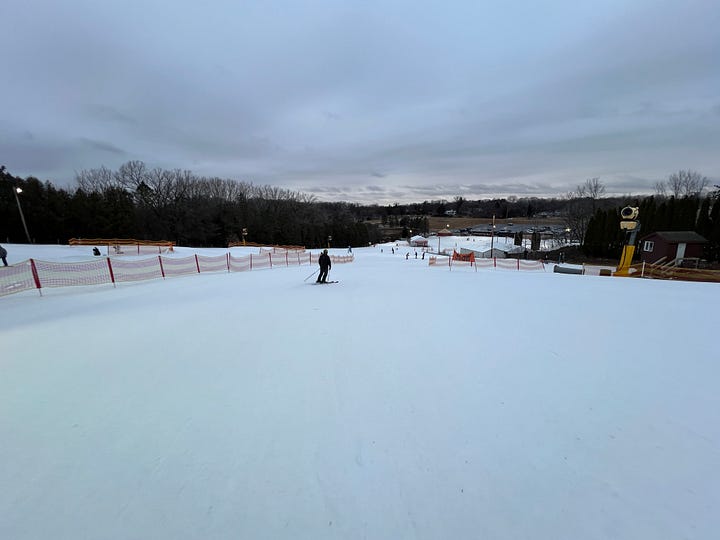

On a subsequent trip to the summit, Schmitz, pointing and dreaming, explains how the ski area could, incredibly, expand.
Schmitz wants to buy more ski areas and I hope he does. “I love skiing our small ski areas,” he told me on the podcast three years ago. This passion is clear skiing while with him. He takes jumps at full speed and glides into ropetows like the kids do, without pause, melting into the machine and its uphill chug. I follow like a child who, hand held, does not bother looking both ways when crossing the street, and I am shocked when, having crested a ramp angling beneath Chair 3, I find myself airborne above a gap jump, a park feature that I avoid like poison. It will be embarrassing to write, I ponder in that split second, that my ski season ended in a suburban Milwaukee terrain park built for 12-year-olds. But instinct intrudes. I lift my legs mid-air, thrust my fists forward in a crouch. Braced for catastrophe, I somehow clear the gap, glide down the backside ramp, and ski off into the dusk.
The Storm partnered with the Slopes ski-tracker app to document my 2024-25 ski season. Read previous installments here (the Slopes promotions referred to in these articles have ended):
December in Skiing, With the Slopes App: Oregon, Catskills, Michigan
Throughout the winter, I document The Storm’s on-the-ground ski adventures in the newsletter. In the past, this section has been buried below a paywall. For this winter, as part of my partnership with the Slopes ski app, I’m splitting this section into its own issue, to show my readers how cool this little tracker is.



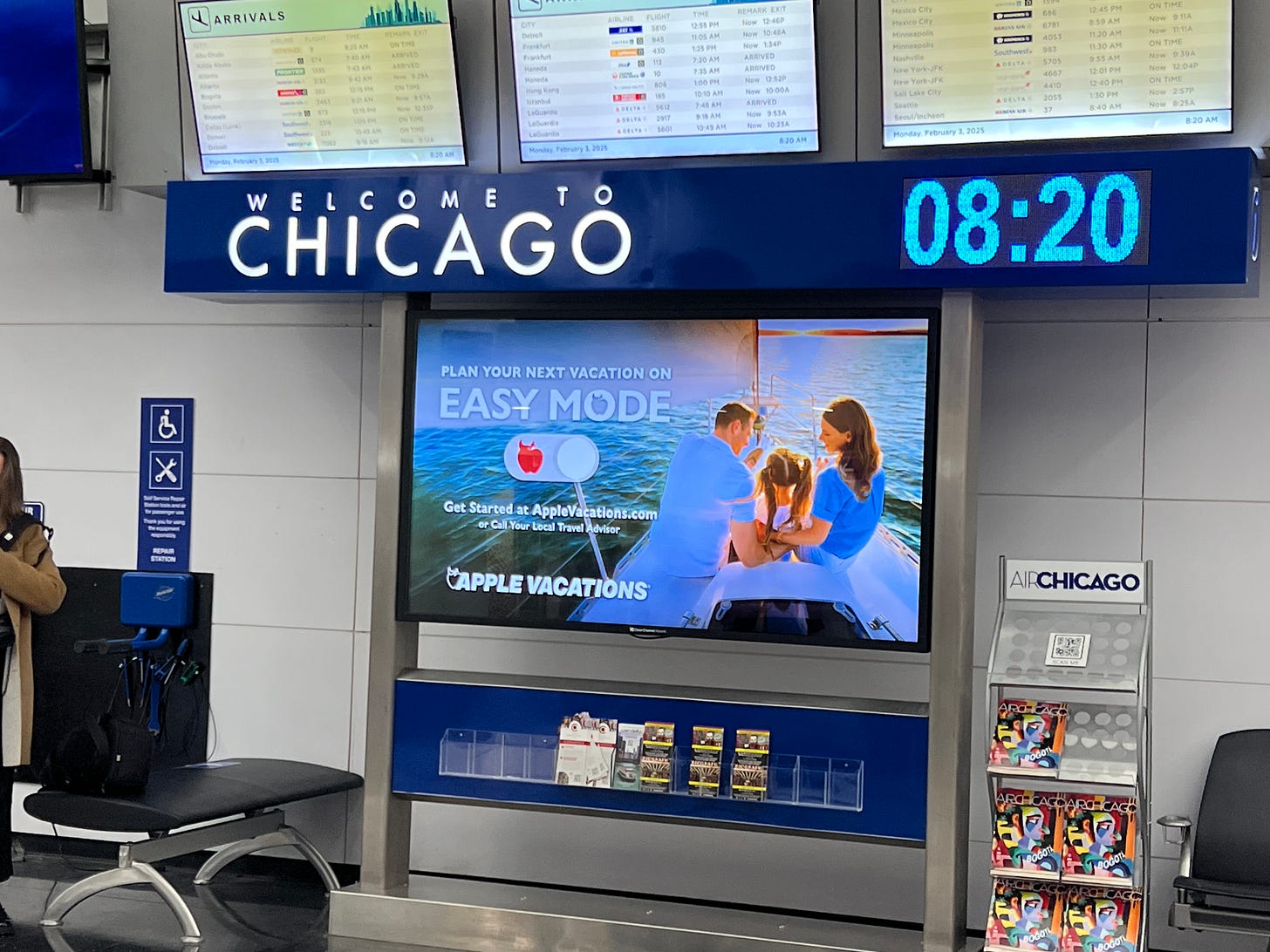

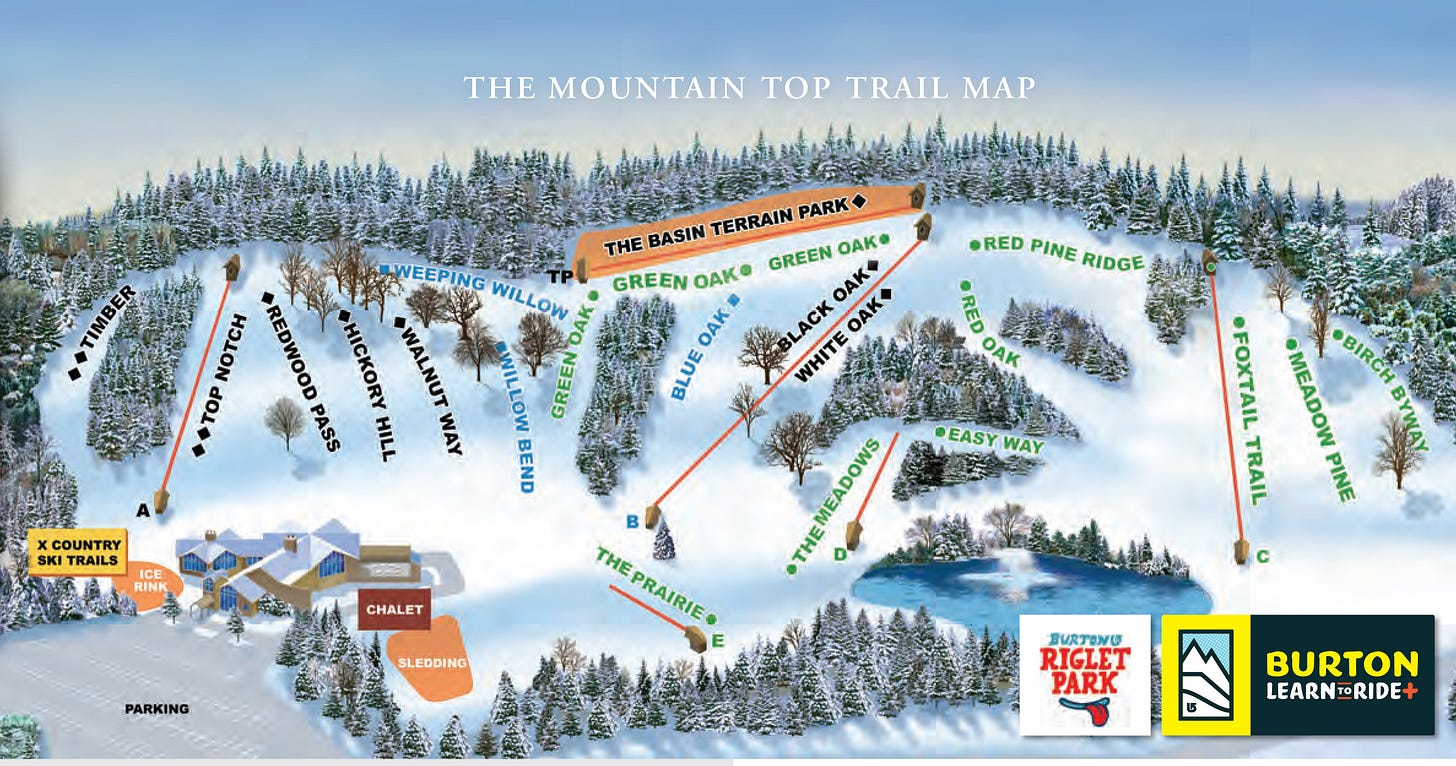
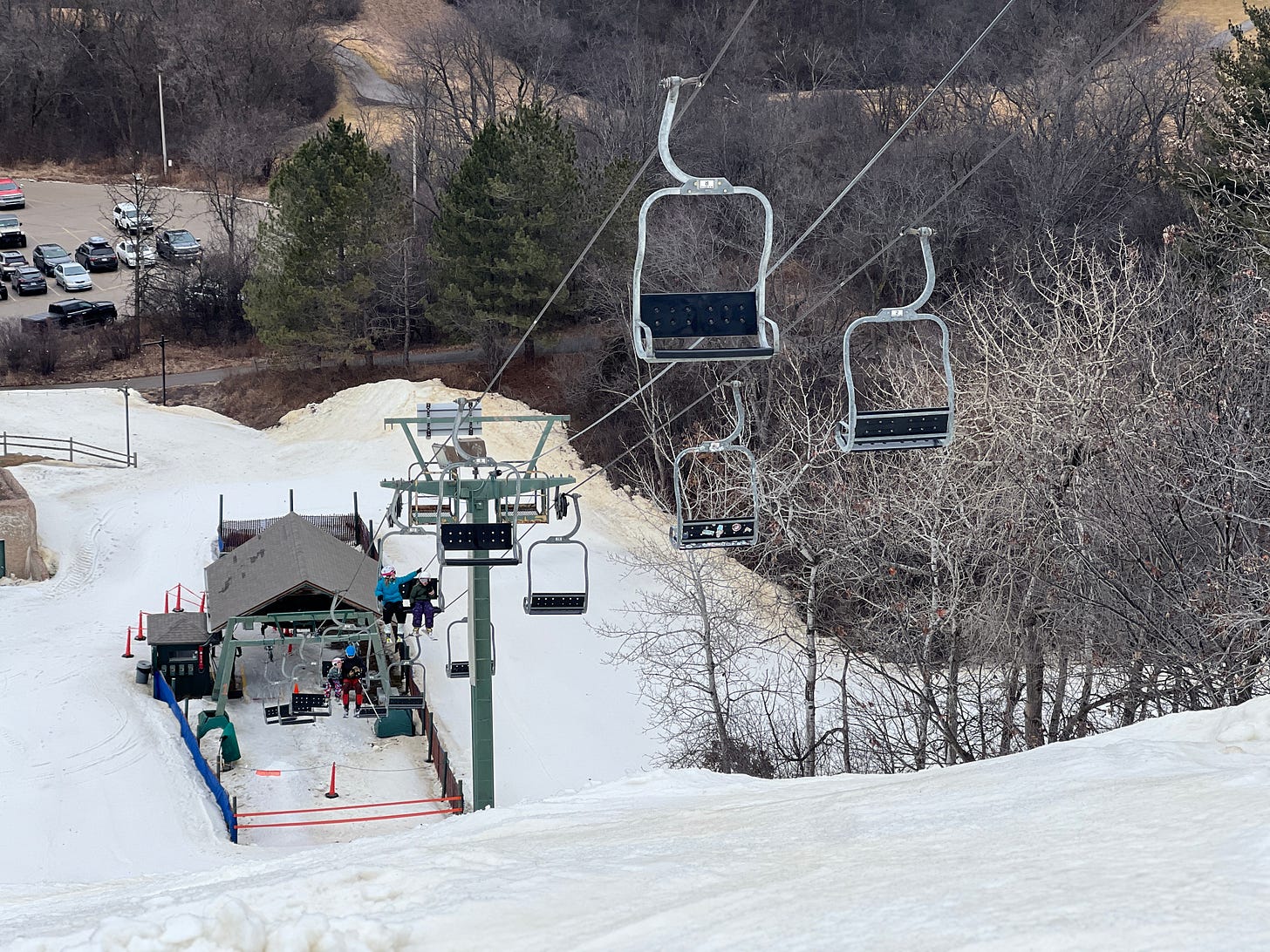




The Storm is rocking! Love the photo accompaniment.
This is literally what my season looks like… with a trip east/west or if lucky both sprinkled in. Thanks for this article, it is spot on WI skiing.